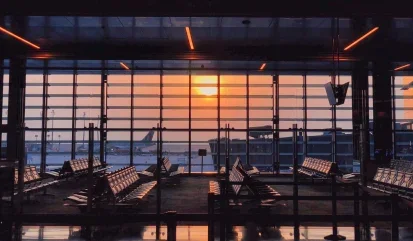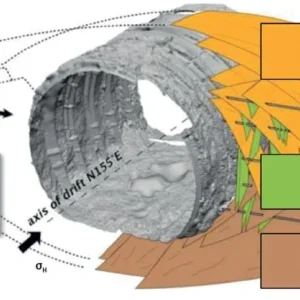
The Heathrow Express Line was the first privately built railway in the UK for many generations, and was to provide an underground link connecting the four terminals of the airport to the main rail line into London Paddington. The twin running tunnels – 5.7m in diameter – were constructed by tunnel boring machine, but the underground project includes two stations within the airport: one at the Central Terminal Area (CTA), and another at the end of the line at Terminal 4 (T4).
The planning and design of the tunnels have been described elsewhere but early concerns were expressed about the nature of the construction of the two station platforms and the effect this might have on the many sensitive structures at ground level within the confines of the airport. The new tunnels were also to pass under the existing London Underground Piccadilly Line.
The geology of the airport is said to be uniform, and consists of approximately 2m of made ground overlying 4-6m of water-bearing gravel, beneath which is some 50m of London Clay. At the stations between the two running tunnels a third central concourse tunnel is included.
The New Austrian Tunnelling Method (NATM) was proposed for the design and construction of the stations, and a trial tunnel was funded by the client early in 1992 to evaluate whether this form of excavation and lining method would be suitable on this site. These were to be the first NATM tunnels undertaken in London Clay.
The British Airports Authority (BAA) was the client and, following the successful evaluation of the NATM system for the station construction, drew up a contract in which the bored tunnels and the NATM station tunnels were let as a ‘design and construct’ package.
The HSE report records that the client opted for an approach using ‘performance specifications’, which meant that the commercial and technical risks of, for example, NATM and any compensation grouting, passed to the respective contractors.
This meant that prospective design and build contractors had to weigh up such risks in the competitive tendering processes, and carry out the work to their own designs and specifications. ‘Self-certification’ of quality was introduced into the contract.
The report says that BAA chose to confine its role to auditing the design and build contractor’s self-certification scheme. Following the evaluation of the bids, the design and build contract was awarded to Balfour Beatty which, as part of this process, had placed a subcontract with Geoconsult of Austria.
Geoconsult was engaged by Balfour Beatty “to design the NATM works and to provide on-site technical supervision”.
The Report also states that Geoconsult’s contract included “supervisory and quality control functions”, but the achievement of quality during construction was the responsibility of Balfour Beatty. The work started on site on 9 May 1994.
The collapse
The collapse, just over five months later, affected three tunnels at CTA which were being worked on at the time. The situation immediately after the collapse at CTA is shown in figure 1, opposite
The concourse tunnel had been excavated and lined, and work was also in hand on the construction of the up-line and down-line tunnels. Balfour Beatty had chosen to drive both platform tunnels together, and the HSE investigation found that Geoconsult had raised no objection to this – nor had anyone else.
During the night shift of 20 October, it became obvious to those on site that there was serious distress in the various tunnel linings and the stability of the three-tunnel system was out of control.
There were extensive and worsening cracking and spalling, and there was severe damage and movement in particular to the invert of the concourse tunnel. Cracking and spalling continued to get worse, and eventually the decision was taken to evacuate the tunnels. No-one was injured.
Three collapses, as indicated on the diagram, occurred over a number of days and the buildings over the tunnels slowly collapsed and were demolished.
HSE report
The HSE report is correctly called “a report on the investigation by the Health & Safety Executive“. It is not the report of a public inquiry or a committee of independent experts, but of a government department team specially brought together.
The team of inspectors of Health & Safety took more than 100 signed statements from those involved and took copies of any documents, files, drawings or photographs pertinent to their enquires.
The team’s remit was to investigate how and why people at work and others in the area were exposed to health and safety risks during and before the collapses. The remit did not extend to determining engineering or contractual ‘blame’, but with underground construction, questions of safety are inevitably linked, for example, to the quality of engineering design and construction, and to other areas like management and procurement.
The title of the report is unfortunate in that other NATM tunnels were under construction at the same time at Heathrow by different designers and constructors. The baggage tunnel, for instance, is generally agreed to have been successful.
The report describes a huge catalogue of errors in design, engineering management, poor construction, poor quality control of the works and a lack of effective engineering management of the project.
According to the information presented, there were enough indications within the various engineering, monitoring and administrative systems that the construction work was falling substantially below the specification in many respects. This was despite the contractor’s quality systems which included:
The report calls particular attention to the design and construction of the central invert joint and it calls attention to the consequential effect of a number of construction defects.
The photograph taken from the HSE report, is a section of tunnel invert taken from another part of the same project. At this location the opposing sides of the central joint are over and under the specified thickness, and there was no reinforcement continuity across the joint.
This invert panel broke apart during recovery. The final failure mechanism of the section of the concourse tunnel postulated by the HSE team demonstrates the safety-critical importance of the invert.
The HSE’s view was that the tunnel monitoring instrumentation for a critical section near to the access shaft indicated that there was continuing movement in the tunnel and in the ground for some months, and that the rate of convergence increased when construction of the adjacent platform tunnels commenced roughly one month before the final collapse.
Prosecutions
Legal proceedings alleging failure to ensure people’s safety were heard in 1999.
The contractor admitted breaches and Geoconsult was found guilty after a trial before a jury. The judge, in his sentencing remarks, described this incident as “one of the worst civil engineering disasters in the United Kingdom in the last quarter of a century”, and no party (including the HSE) escapes criticism.
One person’s disaster is, of course, everyone else’s learning opportunity, and both this report and the previous 1996 HSE Report 4 on the Safety of New Austrian Tunnelling Method Tunnels should be essential reading to those involved in training and education, not just in this particular type of tunnelling system.
However, this report must be seen in context of the good and unusual early work on the trial tunnel commissioned by the client, and the well-managed project work that followed after the collapse.
For those who wish to look back there is a huge amount of detail in the HSE report and other publications, but the more productive way is to look forward.
The identification and control of risk in underground construction is a complex matter and this incident has served to emphasise the point that safety and risk is not just about individual engineering activities and their associated dangers.
It is also a subject intimately bound up in engineering management, procurement, organisational arrangements, and the consideration of human factors.
Related Files
Side gallery crown
Side gallery
Displacement
Camborne House extension







